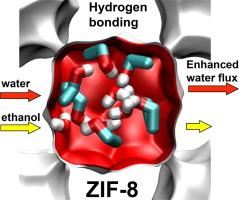强调使用微孔结晶吸附剂进行混合物分离时热力学非理想状态的技术后果
IF 8.1
1区 工程技术
Q1 ENGINEERING, CHEMICAL
引用次数: 0
摘要
本文章由计算机程序翻译,如有差异,请以英文原文为准。

Highlighting the technological consequences of thermodynamic non-idealities in mixture separations using microporous crystalline adsorbents
Microporous crystalline adsorbents such as zeolites, and metal–organic frameworks (MOFs) have potential use in a wide variety of separations applications. Published data from experiments and molecular simulations reveal scenarios in which the Ideal Adsorbed Solution Theory (IAST) fails to provide a quantitative description of mixture adsorption equilibrium. The failure of the IAST is ascribable to non-compliance with one or more tenets mandated by the IAST such as (a) homogeneous distribution of adsorbates within the pore landscape, (b) no preferential location of guest species, and (c) absence of molecular clustering due to say hydrogen bonding. The primary aim of this article is to underscore the technological consequences of thermodynamic non-idealities in separations by undertaking three different case studies.For CO2 capture from humid gases in fixed bed adsorbers packed with CALF-20, the capture efficiency is significantly influenced by the thermodynamic non-idealities, necessitating the use of the Real Adsorbed Solution Theory (RAST) in simulations of adsorption/desorption cycles. The RAST based simulations underscore the strong influence of relative humidity on capture efficiency.The recovery of C2H4 from the reactor products of oxidative coupling of methane (containing CO2), the proper accounting of selectivity reversals induced by non-idealities is the key to the choice of LTA-5A zeolite as adsorbent in the Pressure Swing Adsorption (PSA) scheme. Ignoring thermodynamic non-idealities fails to anticipate selectivity reversals that are essential in the PSA scheme.For dehydration of water/ethanol mixtures in a membrane pervaporation unit, the strong hydrogen bonding between water and ethanol results in enhanced water permeation that is not anticipated by the IAST in zeolites and ZIF-8.
求助全文
通过发布文献求助,成功后即可免费获取论文全文。
去求助
来源期刊

Separation and Purification Technology
工程技术-工程:化工
CiteScore
14.00
自引率
12.80%
发文量
2347
审稿时长
43 days
期刊介绍:
Separation and Purification Technology is a premier journal committed to sharing innovative methods for separation and purification in chemical and environmental engineering, encompassing both homogeneous solutions and heterogeneous mixtures. Our scope includes the separation and/or purification of liquids, vapors, and gases, as well as carbon capture and separation techniques. However, it's important to note that methods solely intended for analytical purposes are not within the scope of the journal. Additionally, disciplines such as soil science, polymer science, and metallurgy fall outside the purview of Separation and Purification Technology. Join us in advancing the field of separation and purification methods for sustainable solutions in chemical and environmental engineering.
 求助内容:
求助内容: 应助结果提醒方式:
应助结果提醒方式:


